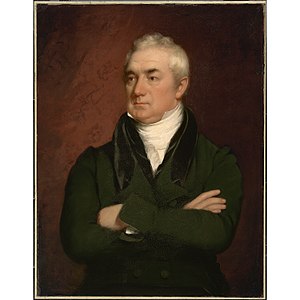Loammi Baldwin, Jr.

|
| Loammi Baldwin, painting by Chester Harding , 1823 |
Loammi Baldwin, Jr. (born May 16, 1780 in North Woburn , Massachusetts , † June 30, 1838 in Charlestown , Massachusetts) was an American lawyer and engineer . Baldwin is considered the nestor of civil engineering in the United States. He made a special contribution to the infrastructural development of the United States (internal improvements) and built the first dry docks in the USA.
Life
family
Loammi Baldwin was the middle of the five sons of the engineer and politician Loammi Baldwin , Sr. (1744 / 45-1807). As a teenager he helped his father build the Middlesex Canal .
Baldwin's brothers, Cyrus Baldwin (1773-1854), Benjamin Franklin Baldwin (1777-1821), James Fowle Baldwin (1782-1862), and George Rumford Baldwin (1798-1888) were also noted engineers.
Loammi Baldwin, Jr. was married twice, first to Ann Williams († 1822) and from 1828 to Catherine Beckford.
Early years
Baldwin first attended Westford Academy and graduated from Harvard College in 1800 . He first worked as a lawyer in the law firm of Timothy Bigelow (1767-1821, Speaker of the House of Representatives from Massachusetts ) in Groton , Massachusetts. Baldwin constructed a fire pump for the place that was in operation for more than eighty years. In 1804 Baldwin was admitted to the bar and settled in Boston . Just three years later, he closed his law firm in order to learn about public construction in England.
Engineering services
In 1807 Baldwin opened an engineering office in Charlestown , Massachusetts. In 1809 he published Thoughts on the Study of Political Economy as Connected with the Population, Industry, and Paper Currency of the United States . In the war of 1812 he was commissioned to build Fort Strong in Boston Harbor . Numerous public construction contracts followed. From 1817 to 1820, Baldwin was a senior engineer for Virginia public works . In this role, he was responsible for surveying the following waters: Rappahannock , Rapidan , Kanawha , James River , Goose Creek and the Richmond Docks . In 1818, together with his brother Benjamin Baldwin, he led various infrastructure measures on the waters of North Carolina as well as canal construction in several states. From 1819 Loammi Baldwin worked as an engineer for the Boston-Roxbury Corporation , whose hydroelectric power station he completed.
From 1821 Baldwin was an engineer for the Union Canal , which was to connect the Schuylkill River with the Susquehanna River . Among other things, Baldwin designed a relatively large-scale route plan for the canal, which included a tunnel more than 200 meters long. In the dispute over construction costs and management style, Baldwin left the construction company in 1823; His successor was Canvass White , who in 1826 implemented a smaller-sized canal. The later economic failure of the canal was ultimately also due to its too small dimensions. In 1824 Baldwin accompanied Francis Lowell on another study trip to Europe, before he worked on the committee for the Bunker Hill Monument from 1825 and designed a railway line between Boston and the Hudson River , which was later realized by his brother James Fowle Baldwin .
The state dry docks of Charlestown , Massachusetts ( Boston Naval Shipyard ) and of Norfolk , Virginia ( Norfolk Naval Shipyard ), the construction of which he and his assistant Alexander Parris also supervised between 1827 and 1835, are considered the most important buildings by Loammi Baldwin . These docks were the first dry docks in the United States and are considered outstanding examples of American engineering of their time. In this, Baldwin also advised the US Navy on other projects, including the Portsmouth Naval Shipyard , New York Naval Shipyard , Philadelphia Naval Shipyard , Pensacola Navy Yard and Washington Navy Yard .
From 1834 Baldwin dealt, among other things, with buildings for water supply and for the generation of hydropower , for example for the Amoskeag Manufacturing Company in Manchester , New Hampshire. He led survey work on the Altamaha River ( Georgia by), built Holworthy Hall at Harvard College and has consulted in the construction of the Louisville and Portland Canal and the Harrisburg Canal operates.
Merits and honors
In 1810 Baldwin was elected to the American Academy of Arts and Sciences , in 1814 to the American Antiquarian Society .
In 1835 he was a member of the Massachusetts Executive Council , in 1836 he was an elector for the presidential election .
Baldwin's engineering firm was one of the first civil engineering training centers in the United States. Baldwin is known as the "father of civil engineering in the United States". His students, including Alexander Parris , Uriah Boyden , Samuel Felton , Gridley JF Bryant, and John W. Brooks , paid him to work in his office but received decent pay for their involvement in his projects. Baldwin made a special contribution to the infrastructural development of the United States ( internal improvements ) .
Buildings (selection)
Web links
- Loammi Baldwin, Jr. in the database of Find a Grave (English)
literature
- Frances C. Robb: Baldwin, Loammi, Jr. In: American National Biography . doi: 10.1093 / anb / 9780198606697.article.1300076
Individual evidence
- ↑ Book of Members 1780 – present, Chapter B. (PDF; 1.2 MB) In: American Academy of Arts and Sciences (amacad.org). Retrieved April 13, 2018 .
- ↑ Members list "B". In: americanantiquarian.org. Retrieved April 13, 2018 .
| personal data | |
|---|---|
| SURNAME | Baldwin, Loammi Jr. |
| BRIEF DESCRIPTION | American lawyer and engineer |
| DATE OF BIRTH | May 16, 1780 |
| PLACE OF BIRTH | North Woburn , Massachusetts |
| DATE OF DEATH | June 30, 1838 |
| Place of death | Charlestown , Massachusetts |






